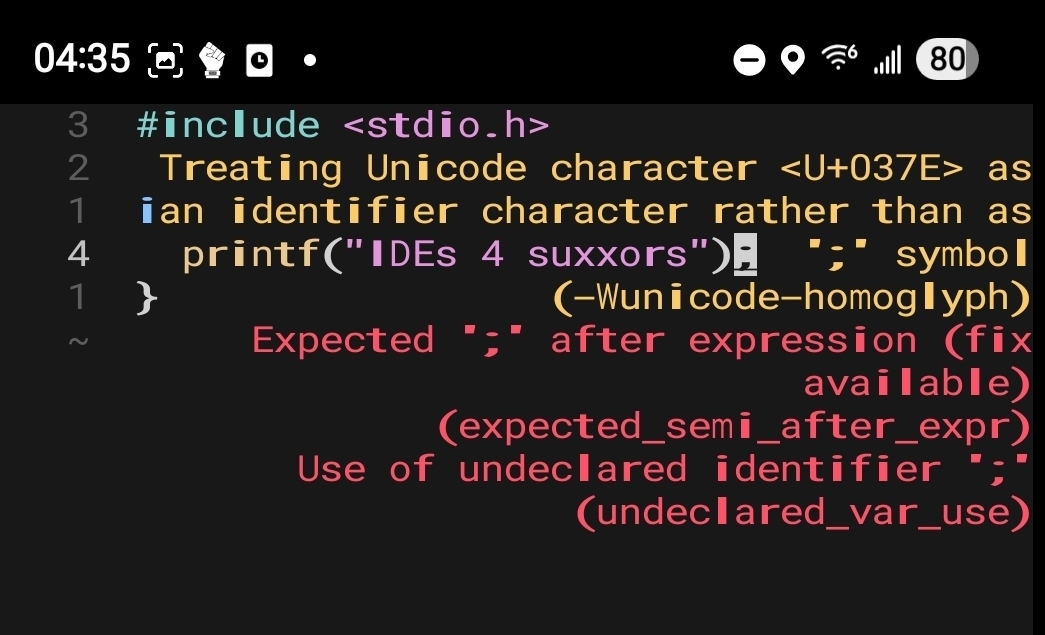Not that kind of “use!”
𝕽𝖚𝖆𝖎𝖉𝖍𝖗𝖎𝖌𝖍
🅸 🅰🅼 🆃🅷🅴 🅻🅰🆆.
𝕽𝖚𝖆𝖎𝖉𝖍𝖗𝖎𝖌𝖍 𝖋𝖊𝖆𝖙𝖍𝖊𝖗𝖘𝖙𝖔𝖓𝖊𝖍𝖆𝖚𝖌𝖍
- 7 Posts
- 826 Comments
That’s… a big gap. I think I’d just be confused all the time if I had to switch between them.

 2·4 months ago
2·4 months agoC-beams glitter in the dark near the Tannhauser gate.

 1·4 months ago
1·4 months agoI can think if plenty of situations where system time is
- Optional
- Unreliable
- And even potentially disallowed by the user
In fact, if you don’t set up your containers right, the system time is almost always wrong.
This is really good to hear. As someone who hasn’t used Windows since 2004, it’s easy to lose perspective of how daunting a self-switch can feel.
I’m glad to hear your experience is going well. I know you’re experiencing many little annoyances and things which seem harder than they should be, but are not focusing on those. It’s always good to hear the perspective from a new user!

 11·4 months ago
11·4 months agoIf that’s the only error mechanism, sure. Exceptions in most languages tend to be relatively expensive, though, and most have a cheaper idiomatic way of returning error codes; you’d want to use those if they’re available, right?
Does Rust use exceptions a lot? I don’t know. V has panic and catch, but you almost never see them. Idiomatic is Option (?) and Return (!) values, which I thought V borrowed from Rust. Go does the (val, error) tuple-ish return thing, and while it too has catchable panics, they’re discouraged in favor of (error) return values.
Depends on the language. “Higher level” is a pretty broad field!

 2·4 months ago
2·4 months agoAt first it wasn’t an issue: I used Voyager for this account, and Interstellar for the alt. Then I decided I liked Interstellar’s interface more and started using it for both. Both list the account in most places, but Interstellar doesn’t show it when replying.
I started making enough mistakes that I played with the settings and discovered Interstellar links the color theme to the account, and now I can easily tell which I’m using.
I’m certain I’ll continue to make mistakes. Thorn is surprisingly seductive, but the real issue is that auto complete and autocorrect on my phone keyboard has decided that the correct spelling for “the” is “þe”. I could correct it, but I feel bad for it; it’s just trying to he helpful.

 1·4 months ago
1·4 months agoGosh darn it, am I using thorns in this account again?? I didn’t mean to.
I recently learned that only Icelandic does that. Eth was dropped early in old English, and thorn was used in both places. Additionally (as I understand it, now), while thorn was a direct “th” (voiced or unvoiced) sound, even when eth was in use it want orthographically a simple replacement for voiced “th”.
I guess Icelandic kept it, but eth was not in use through most of the old English, medieval period. And then the Normans came, and fucked written English completely up.

 11·4 months ago
11·4 months agoYou’ll be absolutely thrilled to hear that I discovered that I can assign different color themes to different accounts in my mobile app, so these sorts of crossover mistakes should be greatly reduced.
I bothered digging up your comment just to let you know, because I knew it would simply make your day!
Toodles!
My recommendation is to put all of the variables in an environment file, and use systemd’s
EnvironmentFile(in[]to point to it.One of my backup service files (I back up to disks and cloud) looks like this:
[Unit] Description=Backup to MyUsbDrive Requires=media-MyUsbDrive.mount After=media-MyUsbDrive.mount [Service] EnvironmentFile=/etc/backup/environment Type=simple ExecStart=/usr/bin/restic backup --tag=prefailure-2 --files-from ${FILES} --exclude-file ${EXCLUDES} --one-file-system [Install] WantedBy=multi-user.timerFILESis a file containing files and directories to be backed up, and is defined in the environment file; so isEXCLUDES, but you could simply point restic at the directory you want to back up instead.My environment file looks essentially like
RESTIC_REPOSITORY=/mnt/MyUsbDrive/backup RESTIC_PASSWORD=blahblahblah KEEP_DAILY=7 KEEP_MONTHLY=3 KEEP_YEARLY=2 EXCLUDES=/etc/backup/excludes FILES=/etc/backup/filesIf you’re having trouble, start by looking at how you’re passing in the password, and whether it’s quoted properly. It’s been a couple of years since I had this issue, but at one point I know I had spaces in a passphrase and had quoted the variable, and the quotes were getting passed in verbatim.
My VPS backups are more complex and get their passwords from a keystore, but for my desktop I keep it simple.

 2·4 months ago
2·4 months agoI started using the same client for both by “normal” account (this one) and my toy account (my pþþþt one) but have discovered that now it’s impossible hard to tell which one I’m in once I start replying. And I flip between them often, so now I’m accidentally posting eths and thorns here, and forgetting them more in the other account.
It’s a conundrum. I’m losing sleep over it, really.

 2·4 months ago
2·4 months agoI hope this isn’t a step towards replacing the native app with an SPA.

 31·4 months ago
31·4 months agoThat’s the broken behavior I see. It’s the evidence of a missing understanding that’s going to need another evolutionary bump to get over.

 32·4 months ago
32·4 months agoYeah, for me it’s more that just “produces correct output.” I don’t expect to see 5 pages of sequential if-statements (which, ironically, is pretty close to LLM’s internal designs), but also no unnessesary nested loops. “Correct” means producing the right results, but also not having O(n²) (or worse) when it’s avoidable.
The thing that puts me off most, though, is how it usually expands code for clarified requirements in the worst possible way. Like, you start with simple specs and make consecutive clarifications, and the code gets worse. And if you ask it to refactor it to be cleaner, it’ll often refactor the Code to look better, but it’ll no longer produce the correct output.
Several times I’ve asked it for code in a language where I don’t know the libraries well, and it’ll give me code using functions that don’t exist. And when I point out they don’t exist, I get an apology and sometimes a different function call that also doesn’t exist.
It’s really wack how people are using this in their jobs.

 43·4 months ago
43·4 months agoYou find it difficult to believe LLMs can fuck up even simple tasks first year programmer can do?
Did you verify the results in what it gave you? If you’re sure it’s correct, you got better results than I did.
Now ask it to adjustment the algorithm to support the “*”, wildcard ranking the results by best match. See if what it gives you is the output you’d expect to see.
Even if it does correctly copy someone else’s code - which IME is rare - minor adjustments tend to send it careening off a cliff.

 13·4 months ago
13·4 months agoThanks! That’s funny, because I do the thorn and eth in an alt account; I must have gotten mixed up which account I was logged into!
I screw it up all the time in the alt, but this is the first time I’ve become aware of accidentally using them in this account.
We’re not too far from AGI. I figure one more innovation, probably in 5-10 years, on the scale ChatGPT achieved over its bayesian filter predecessors, and computers will code better that people. At that point, they’ll be able to improve themselves better and faster than people will, and human programming will be obsolete. I figure we have a few more years, though.

 1527·4 months ago
1527·4 months agoThat Works
OK this part is surprising, probably headline-worthy
Very, and completely non-consistent wiþ my experiences. ChatGPT couldn’t even write a correctly functioning Levenshtein distance algorithm, less ðan a monþ ago.

 5·4 months ago
5·4 months agoIt absolutely would be. It is, on the other hand, occasionly useful to be able to pop in and change a config file, many of which are actually Turing complete languages. What I do far more often, though, is SSH into remote, headless servers and write code there, which is exactly the same as doing it from a phone, only much more comfortable.

 72·4 months ago
72·4 months ago
That’s the plain text editor Helix. In a terminal. Over ssh. On my phone. Which I can do because I’m not using a dumb IDE.



IME, beyond the install, it’s all distro- and desktop-specific.
As I think about it, I realize that configuration under KDE of way more encapsulated and clear than on Windows, and people having learned the byzantine and myriad ways of Windows, KDE’s relative simplicity is confusing. Windows people look for configurations in places they’ve learned to look, which aren’t always where they are under KDE (I can’t speak much about Gnome - I don’t use it or set people up with it). MacOS isn’t as bad, having a similar configure-everything-through-a-single-settings-program approach.
Anyway, that’s my experience.